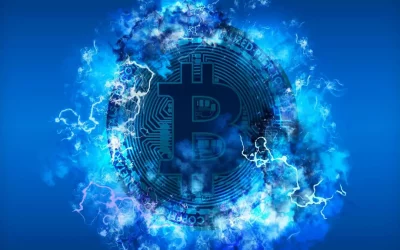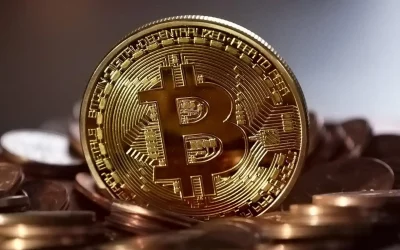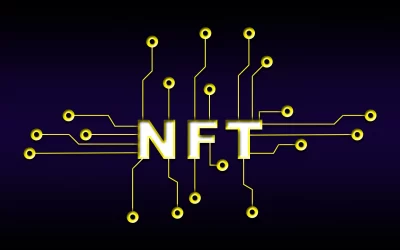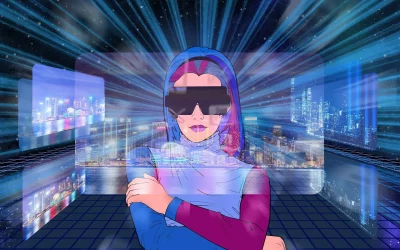NFT
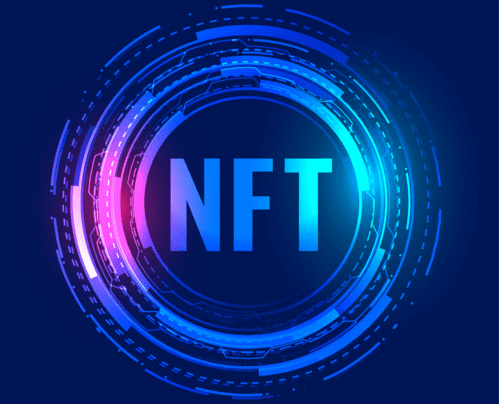
Imagine buying a digital artwork on the Internet for a reasonable price and getting a unique digital token that proves your authority over the artwork you purchased. Wouldn’t that be great? Well, this opportunity exists now, thanks to NFTs.
NFTs are currently taking the world of digital art and collectibles by storm. Just as everyone in the world believed that Bitcoin was the digital answer to currency, NFTs are now being presented as the digital answer to collectibles. As a result, digital artists are seeing their lives changed by massive sales to a new audience of cryptocurrencies.
If you are interested in NFTs and want to explore more about what they are, you are in the right place. Let’s dive in and see what it’s all about!
WHAT ARE NFTS
NFT means non-fungible tokens (NFTs), which are generally created using the same type of programming used for cryptocurrencies. Simply put, these cryptographic resources are based on blockchain technology. They cannot be exchanged or traded equivalently like other cryptographic resources such as Bitcoin or Ethereum.
The term NFT clearly represents the fact that it can neither be replaced nor exchanged because it has unique properties. Physical currency and cryptocurrency are fungible, which means they can be traded or exchanged for each other; NFT stands for non-fungible token, which means that each individual NFT can neither be replaced nor exchanged because it has unique properties.
Main characteristics of NFT –
Digital resource – NFT is a digital resource that represents collectibles on the Internet such as art, music and games with an authentic certificate created by the blockchain technology behind cryptocurrency.
Unique – Cannot be counterfeited or otherwise manipulated.
Exchange – The buying and selling of NFT is done with cryptocurrencies such as Bitcoin on specialized sites.
HOW THEY WORK
Most NFTs reside on the Ethereum cryptocurrency blockchain, a distributed public ledger that records transactions.
NFTs are individual tokens with valuable information stored within them.
Because they hold a value determined primarily by market and demand, they can be bought and sold just like other physical types of art.
The unique data of NFTs simplify the verification and validation of their ownership and the transfer of tokens between owners.
WHAT THEY ARE FOR
People interested in cryptocurrency trading and people who like to collect artwork often use NFT. In addition to this, it also has other uses such as:
Digital content – The most significant use of NFT today is in digital content. Content creators see their profits boosted by NFTs as they fuel an economy in which creators have additional ownership of their content on the platforms they use to advertise it.
Game Items – NFTs have garnered considerable interest from game developers. NFTs can provide many benefits to players. Normally, in an online game, you can purchase items for your character, but that is not all. With NFTs, you can get your money back by selling the items once you are done with them.
Investments and collateral – Both NFTs and DeFi (decentralized finance) share the same infrastructure. DeFi applications allow you to borrow money using collateral. NFT and DeFi are both collaborating to explore the use of NFTs as collateral.
Domain names-NFTs provide your domain with a name that is easier to remember. It works like a Web site’s domain name, making its IP address more memorable and valuable, usually based on length and relevance.
Even celebrities such as Snoop Dogg, Shawn Mendes and Jack Dorsey are taking an interest in NFT by releasing unique mementos and artwork and selling them as NFT.
NBA Top Shot is a great use case for understanding the NFT trend
One of the most popular non-fungible tokens in recent days is NBA Top Shot, a partnership between Dapper Labs (creators of the game CryptoKitties) and the National Basketball Association (NBA). The NBA licenses individual video highlight reels, among other content, to Dapper Labs, which digitizes the footage and makes it available for sale to consumers. Each reel shows a video clip, such as a famous player’s dunk, some with different angles and digital graphics to make them unique. Even if someone has made a perfect copy of the video, it can be instantly recognizable as counterfeit. The venture has already generated $230 million in sales, and the company also just received $305 million in funding from a group that includes Michael Jordan and Kevin Durant.
These “digitized video reels” are sold at high prices. Among the most popular:
LeBron James’ “Cosmic” Dunk: $208,000
Zion Williamson “Holo MMXX” block: $100,000
LeBron James “From Above” block: $100,000
LeBron James “Throwdowns” dunk: $100,000
LeBron James’ “Holo MMXX” dunk: $99,999
Steph Curry’s “Deck the Hoops” runs: $85,000
Giannis Antetokounmpo “Holo MMXX” Dunk: $85,000
LeBron James “From the Top” Dunk: $80,000
HOW COME THEY ARE BECOMING POPULAR?
NFTs have actually been around since 2015, but they are now experiencing a surge in popularity due to several factors. The first, and perhaps the most obvious, is the normalization and excitement of cryptocurrencies and the underlying blockchain frameworks. Beyond the technology itself is the combination of fandom, the economics of royalties, and the laws of scarcity. All consumers want to have the opportunity to own unique digital content and potentially hold it as a type of investment.
When someone purchases a non-fungible token, they acquire ownership of the content. In this way, an NFT can gain popularity: the more it is viewed and appreciated online, the more value it develops. When the resource is sold, the original creator gets a slice of the profit equal to 10 percent of the value for which it was traded, with the platform getting a small percentage and the seller getting the rest of that revenue. Therefore, the potential exists for continued revenue from popular digital assets as they are bought and sold over time.
Authenticity is the key to the value an NFT can purchase. Digital collectibles contain distinctive information that makes them distinct from any other NFT and easily verifiable, thanks to the blockchain. The creation and circulation of fake collectibles does not work because each item can be traced back to the original creator or issuer. And, unlike cryptocurrencies, they cannot be traded directly with each other (like baseball cards in real life) because no two are alike.
ARE NFTS NOW MAINSTREAM?
So with all the hype about NFTs, is it fair to say that they are now mainstream? This article provides a solid argument for believing that NFTs are now entrenched in the public consciousness. Reason why a number of high-profile celebrities have ventured into the NFT waters.
MAIN DIFFERENCE BETWEEN NFTS AND CRYPTOCURRENCIES
Although NFTs are created using the same kind of programming language as other cryptocurrencies, this is where the similarity ends:
Cryptocurrencies are “fungible”; they can be traded or exchanged for each other. They also have the same value. For example, one Bitcoin is always the same as another Bitcoin, or one Dollar is always the same as one Dollar.
Each NFT acts as a digital signature that makes it impossible to exchange or equal each other. For example, The Last Supper is a painting of a certain type and cannot be exchanged for another painting.
ETHEREUM AND NFTS
Ethereum’s blockchain enables NFTs to function for several reasons:
NFT trading, without the need for peer-to-peer platforms, can take significant cuts as compensation.
All Ethereum products share the same “backend,” making NFTs portable to buy on one product and sell on another effortlessly.
Once a transaction is confirmed, it is impossible to manipulate data to falsify ownership.
Ethereum is a very robust blockchain, currently free of critical disruptions in its mainnet, which means your tokens will always be available for sale.
Pudgy Penguin is a popular non-fungible token community that represents ownership in a unique resource: 8,888 penguins on the Ethereum blockchain, organized into a single collection. Pudgy Penguin is just one of many communities out there that offer benefits to members, such as having a subscription on a shared Discord server or getting access to a private Telegram channel that allows you to talk to other owners. In fact, many NFT projects have their own communities, where members can collaborate, share ideas, and support or purchase each other’s projects or artwork.
HOW TO PURCHASE NFT?
Having understood what NFTs are for and its specific advantages over other cryptocurrencies, you may want to venture into buying NFTs. If so, you will need to acquire a few essentials before doing so:
You will need a digital wallet that allows you to store your cryptocurrency NFTs, for example Coinbase, MetaMask, and Rainbow.
Consequently you need to purchase some cryptocurrency , which you can do conveniently on our site, depending on the currencies accepted by your NFT provider.
After you have made your cryptocurrency purchase, you can move it from the exchange to your wallet.
Keep in mind that many exchanges charge a small percentage of the cryptocurrency purchase transaction as fees.
Popular NFT markets
Once you have your wallet ready, all you need to do is buy NFTs. Currently, the largest NFT markets are:
Rarible – Rarible is a democratic marketplace that allows artists and creators to issue and sell NFTs. It allows holders to rate features such as commissions and community rules.
OpenSea – To get started, all you have to do is create an account on the official OpenSea website and browse NFT collections and discover new artists. This platform is known to be a vast collection of rare digital objects and collectibles.
Foundation – On this platform, artists must receive or send an invitation from other creators to publish their art. The exclusivity of this community boasts artwork of higher caliber, assuming demand for NFT remains at current levels or even increases over time.
“MINTING” AN NFT: WHAT IT MEANS
Creating an NFT from scratch, or making public an NFT already created by someone else, which will consequently gain value based on so-called attributes, that is, those ancillary graphical features that make it more or less unique. To do this requires access to a blockchain and an NFT marketplace. “Mint NFT” basically means uniquely publishing your token on the blockchain to make it purchasable.
The first step is to open a crypto wallet, particularly one that can securely store cryptocurrencies (e.g. Coinbase, MetaMask and Rainbow). That done, you can purchase a small amount of cryptocurrency to cover the cost of mint NFT. Finally, you need to connect the wallet you created to a marketplace such as Rarible, OpenSea, or Zora.
Now that you have a wallet, you can create NFTs.
If you wish to create your own from scratch, first step is to create the digital file (any digital file, such as JPEG, MP3, GIF or PNG, compatible with your preferred marketplace). You can choose to “create a collectible” as a single image or multiple images. Depending on which marketplace you have linked your wallet to, you can add a name, description, price, and other metadata to your token.
Once the NFT is created, the marketplace may charge you a small publishing fee, which will be taken from your wallet. The act of adding the metadata and publishing it makes the work “minted.” Now, your NFT can be put up for sale on your chosen marketplace. There is also an option to keep the NFT private. After the NFT is on the marketplace, users can bid on it.
You can also set royalty percentages (10 to 30 percent) that go to the artist from sales of their work on secondary marketplaces, after the initial sale on the marketplace of their choice.
If you create digital art, the mint from your NFTs can become a valuable revenue stream. Although there are more complicated methods for coding and creating NFTs, there are numerous online marketplaces and wallets that make it easy to create a saleable digital artwork.
WHAT DOES THE FUTURE OF NFTS LOOK LIKE?
NFTs have improved media exposure and special benefits for aspiring artists on social media. Recently, Jack Dorsey, CEO and co-founder of Twitter, with his first and famous tweet, “I just installed my twttr,” and Vignesh Sundaresan, known as “Metakovan,” purchased $69.3 million worth of NFT artwork on Beep.
Because of its growing popularity, people are now willing to pay hundreds of thousands of dollars for NFT.
Like David Gerard, author of Attack of the 50-foot Blockchain, many experts in the cryptocurrency industry say that about 40 percent of new cryptocurrency users will use NFTs as an entry point. As a result of its growing popularity, NFT could be a more significant part of the digital economy in the future.








